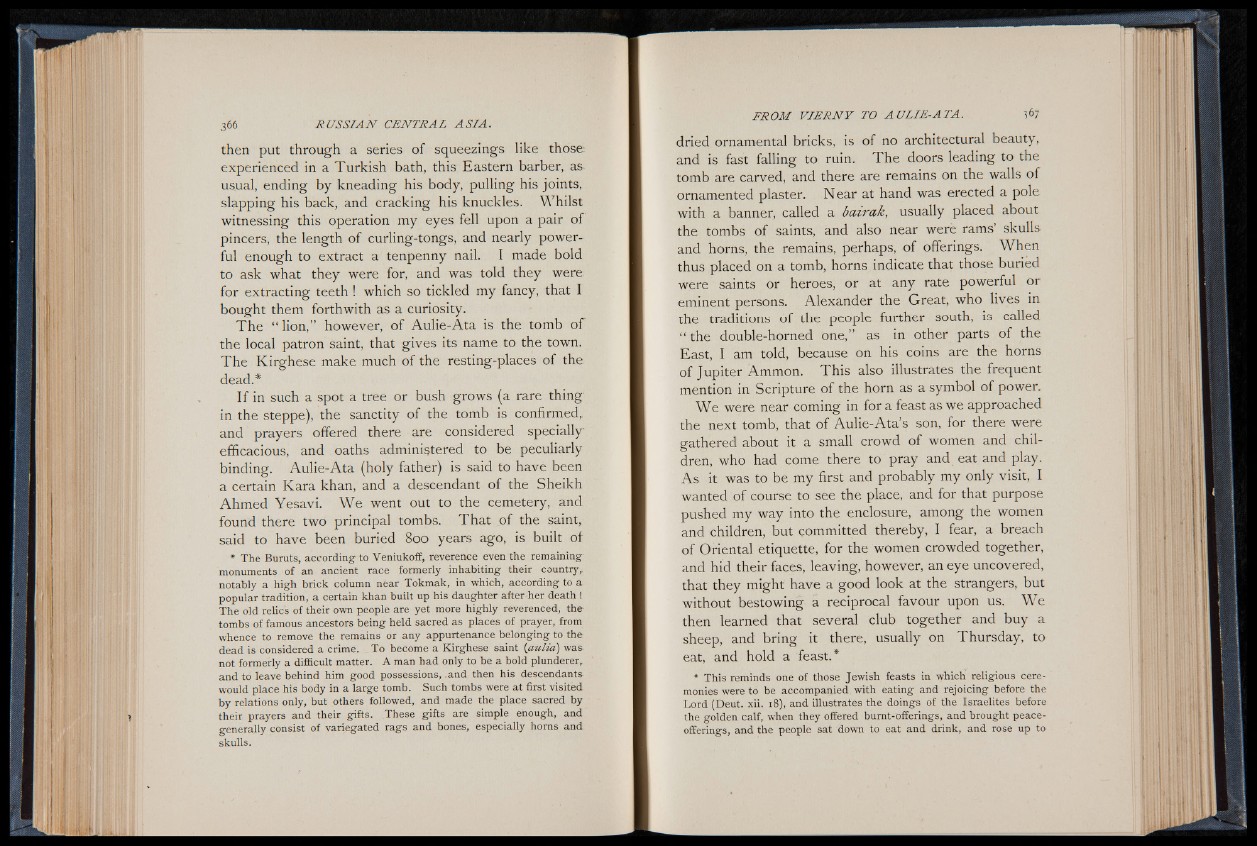
then put through a series of squeezings like those:
experienced in a Turkish bath, this Eastern barber, as-
usual, ending by kneading his body, pulling his joints,
slapping his back, and cracking his knuckles. Whilst
witnessing this operation my eyes fell upon a pair of
pincers, the length of curling-tongs, and nearly powerful
enough to extract a tenpenny nail. I made bold
to ask what they were for, and was told they were
for extracting teeth ! which so tickled my fancy, that I
bought them forthwith as a curiosity.
The “ lion,” however, of Aulie-Ata is the tomb o f
the local patron saint, that gives its name to the town.
The Kirghese make much of the resting-places of the
dead.*
If in such a spot a tree or bush grows (a rare thing
in the steppe), the sanctity of the tomb is confirmed,
and prayers offered there are considered specially
efficacious, and oaths administered to be peculiarly
binding. Aulie-Ata (holy father) is said to have been
a certain Kara khan, and a descendant of the Sheikh
Ahmed Yesavi. We went out to the cemetery, and
found there two principal tombs. That of the saint,
said to have been buried 800 years ago, is built of
* The Buruts, according to Veniukoff, reverence even the remaining'
monuments of an ancient race formerly inhabiting their country,
notably a high brick column near Tokmak, in which, according to a
popular tradition, a certain khan built up his daughter after her death !
The old relics of their own people are yet more highly reverenced, the
tombs of famous ancestors being held sacred as places of prayer, from
whence to remove the remains or any appurtenance belonging to the
dead is considered a crime. To become a Kirghese saint [aulia) was
not formerly a difficult matter. A man had only to be a bold plunderer,
and to leave behind him good possessions, .and then his descendants
would place his body in a large tomb. Such tombs were at first visited
by relations only, but others followed, and made the place sacred by
their prayers and their gifts. These gifts are simple enough, and
generally consist of variegated rags and bones, especially horns and
skulls.
dried ornamental bricks, is of no architectural beauty,
and is fast falling to ruin. The doors leading to the
tomb are carved, and there are remains on the walls of
ornamented plaster. Near at hand was erected a pole
with a banner, called a bairak, usually placed about
the tombs of saints, and also near were rams’ skulls
and horns, the remains, perhaps, of offerings. When
thus placed on a tomb, horns indicate that those buried
were saints or heroes, or at any rate powerful or
eminent persons. Alexander the Great, who lives in
the traditions of the people further south, is called
“ the double-horned one,” as in other parts of the
East, I am told, because on his coins are the horns
of Jupiter Ammon. This also illustrates the frequent
mention in Scripture of the horn as a symbol of power.
We were near coming in for a feast as we approached
the next tomb, that of Aulie-Ata’s son, for there were
gathered about it a small crowd of women and children,
who had come there to pray and eat and play.
As it was to be my first and probably my only visit, I
wanted of course to see the place, and for that purpose
pushed my way into the enclosure, among the women
and children, but committed thereby, I fear, a breach
of Oriental etiquette, for the women crowded together,
and hid their faces, leaving, however, an eye uncovered,
that they might have a good look at the strangers, but
without bestowing a reciprocal favour upon us. We
then learned that several club together and buy a
sheep, and bring it there, usually on Thursday, to
eat, and hold a feast.*
* This reminds one of those Jewish feasts in which religious ceremonies
were to be accompanied with eating and rejoicing before the
Lord (Deut. xii. 18), and illustrates the doings of the Israelites before
the golden calf, when they offered bumt-offerings, and brought peace-
offerings, and the people sat down to eat and drink, and rose up to